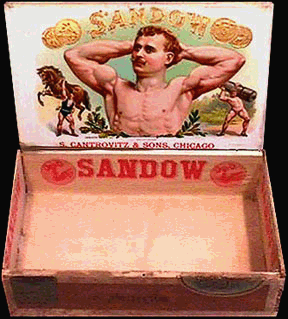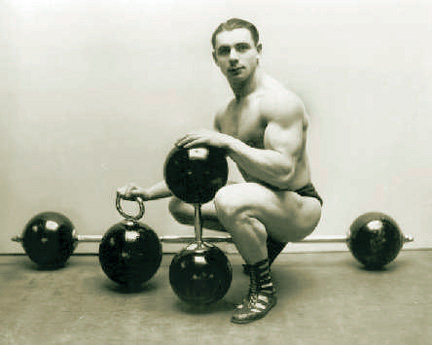SIGN GUESTBOOK |
READ GUESTBOOK |
|
FEMALE GALLERIES |
INDEX |
SIGN GUESTBOOK |
READ GUESTBOOK |
|
FEMALE GALLERIES |
INDEX |
![]()
As we have seen, bodybuilding was born in Europe in the second half of 19th century. In the USA, the situation was different. While in Europe men like Sandow trained themselves to concieve muscles and force, in the USA it was the healt's movement to promote exercise.
We can say that the bodybuilding arrived in the United States at the
beginning of 20th century. Sandow himself went to
Chicago in 1894 to pose as a greek statue in the World Fair and to
make a show, the so called "Sandow Trocadero Vaudevilles",
in which he demonstrated his force and showed his muscles.
Sandow visited a lot of countries, promoting bodybuilding. Obviously, he
had some interest doing this: he invented the "Sandow's
dumbbell", a particular kind of dumbbell made of springs, and
he send a manual about this tool to the families of all the kingdom
and sovereigns of Europe.
As I've said, Sandow was a very cunning
businessman. The following images illustrate this concept.


Left: An advertisment of Sandow's dumbbells. Right: A box of Sandow's cigars.
Charles Atlas
At the beginning of 20th century we have the
first important competition of bodybuilding. In fact, in 1903,
Bernarr McFadden promoted
the first edition of America's Most Perfectly Developed Man.
The price for this competition was $1'000, a considerable
fortune.
The competion was opened to athlets of all disciplines,
but it was manifest that the best bodies were built with weights and
not with other kinds of exercise. The winner of the first edition was
Al Treolar,
while Beatrice Marshall won the
prize for the best woman. You can find the film of this competition
in Internet at the address:
http://www.sandowmuseum.com/treolarfilm.html
for free.

Bernarr McFadden. Photo of 1893.
Bernarr McFadden substained that the physical weakness is an immoral fact and founded the revue "Physical Culture" to promote his ideas. He continued to pratice his ideas, running shoeless from Riverside Drive in New York to the center of the city, up to the age of 70 years.
The winner of 1921 edition was Angelo Siciliano (1893 - 1972). A skilful copywriter, Charles Roman, suggested him to change his name into Charles Atlas.

Angelo Siciliano (Charles Atlas). He posed as a model for 75 statues and trained Rocky Marciano, Joe di Maggio and Robert Ripley. "Dynamic Tension TM" exists also today.
Atlas was an italian boy expatriate in America, and became very
rich and famous inventing the course of "Dynamic tension
TM". This course was translated into seven
languages and was bought by more than 60 thousand people every year.
It consisted in exercises for the various muscles of the body.
Truly speaking, Atlas used weights and not
"Dynamic tension TM" to build his muscles; however, the
exercises were effective. A curiosity: Siciliano
took inspiration for "Dynamic tension TM" looking
the exercises done by the animals in a zoo.
Atlas won the competition of Most Perfectly Developed Man
also in 1922. The measures of his body were: chest 120 cm, thight 60 cm,
waist 81 cm, biceps 43 cm, neck 43 cm.
Compare this measures with
Sandow's at the age of 32: chest 124 cm, tight 63 cm, waist 91 cm,
biceps 45 cm, neck 44 cm. Thus Sandow was massiver than Atlas.
Sigmund Klein
As we have said in the previous chapter, Attila openened a gym in New York.
A german boy migrated to Cleveland (Ohio, USA), Sigmund
(Sig) Klein (1902 - 1987),
went to the Attila's gym to know the famous strongman.
Unfortunately, Attila passed away only a short time before.
The gym was closed, but Klein spoke with Attila's widow and obtained to
re-open the gym. He tested exercises and equipments, understanding
the best of them to concieve results in a short time. Some of these
results are valid also today. Klein married Attila's youngest
daughter and then he opened his own studio. It was a trainer of great
champions, also Steeve Reeves and John
Grimek.

Sigmud Klein. You can see a barbell (rear, horizontal), a dumbbell (in Klein's left hand, vertical) and a shot with an handle - also known as bell (in Klein's right hand).
The first competitions of bodybuilding
The competition of Mr. America
was the world's most important competition for many years. Up to the
second world war, there was not a great distinction between
bodybuilding and weightlifting. Truly speaking, the competition of
bodybuilding were done in the night, after weightlifting
competitions.
In fact, AAU (American Athletic Union)
forced the bodybuilders to make first the lifts and then the poses.
A similar situation was surely frustanting for the first bodybuilders:
they were obliged to pose in the night, when almost all the
spectators were already gone home.
The first edition of Mr. America (America's finest physique) was
promoted by Johnny Hordines
in 1938 and was won by Bert Goodrich. Goodrich
won also the next edition.
From 1940, Mr. America was promoted by
AAU. The first AAU Mr. America was the great
John Grimek (see next chapter).
This table displays the measurements of the first Mr. America winners (font: Muscle Memory by Tim Fogarty). Measurements are in feet and inch (' and ") and in cm for lenghts, in pounds (lbs.) and kg for weights.
| Year | Name | Height | Weight | Neck | Arm | Forearm | Chest | Waist | Thigh | Calf | Wrist | Ankle |
|---|---|---|---|---|---|---|---|---|---|---|---|---|
| 1939 | Bert Goodrich | 5'10.5" 179 cm |
195 lbs. 88.45 kg |
17" 43.18 cm |
17" 43.18 cm |
14" 35.56 cm |
47" 119.38 cm |
33" 83.82 cm |
24" 61 cm |
17" 43.18 cm |
7.6" 19.3 cm |
9.2" 23.36 cm |
| 1940 1941 |
John Grimek | 5'8.5" 174 cm |
195 lbs. 88.45 kg |
17" 43.18 cm |
17.5" 44.45 cm |
14" 35.56 cm |
47" 119.38 cm |
31" 78.74 cm |
25" 63.5 cm |
17" 43.18 cm |
8" 20.32 cm |
9.8" 24.89 cm |
| 1942 | Frank Leight | 5'11.5" 181.61 cm |
209 lbs. 94.8 kg |
17.5" 44.45 cm |
17.5" 44.45 cm |
14" 35.56 cm |
48.5" 123.19 cm |
33" 83.82 cm |
24" 61 cm |
16" 40.64 cm |
8" 20.32 cm |
9.5" 24.13 cm |
| 1943 | Jules Bacon | 5'7" 170.18 cm |
175 lbs. 79.37 kg |
15.5" 39.37 cm |
15.5" 39.37 cm |
12.5" 31.75 cm |
44" 111.76 cm |
31" 78.74 cm |
23" 58.42 cm |
15" 38.1 cm |
7" 17.78 cm |
9" 22.86 cm |
| 1944 | Steve Stanko | 5'11.5" 181.61 cm |
223 lbs. 101.15 kg |
18" 45.72 cm |
18" 45.72 cm |
14.3" 36.32 cm |
48.5" 123.19 cm |
35.9" 91.18 cm |
N.A. | 17" 43.18 cm |
8" 20.32 cm |
10" 25.4 cm |
| 1945 | Clarence Ross | 5'9.5" 176.53 cm |
185 lbs. 83.91 kg |
16.5" 41.91 cm |
17" 43.18 cm |
13.5" 34.29 cm |
47" 119.38 cm |
32" 81.28 cm |
24" 61 cm |
16" 40.64 cm |
7.5" 19.05 cm |
9.2" 23.36 cm |
| 1946 | Alan Stephan | 5'11.5" 181.61 cm |
205 lbs. 93 kg |
17.1" 43.43 cm |
17" 43.18 cm |
14.2" 36.07 cm |
47.9" 121.66 cm |
32.4" 82.29 cm |
24.8" 63 cm |
16.1" 40.89 cm |
7.7" 19.55 cm |
9.7" 24.63 cm |
| 1947 | Steve Reeves | 6'1" 185.42 cm |
213 lbs. 96.61 kg |
17.6" 44.7 cm |
17.5" 44.45 cm |
14" 35.56 cm |
48" 121.92 cm |
31" 78.74 cm |
25.3" 64.26 cm |
17.5" 44.45 cm |
7.9" 20.06 cm |
9.8" 24.89 cm |
| 1948 | George Eifferman | 5'7.5" 171.45 cm |
195 lbs. 88.45 kg |
16.5" 41.91 cm |
16.7" 42.41 cm |
13.4" 34.03 cm |
47.5" 120.65 cm |
32" 81.28 cm |
25" 63.5 cm |
16" 40.64 cm |
7.3" 18.54 cm |
9.6" 24.38 cm |
| 1949 | Jack Delinger | 5'6" 167.64 cm |
195 lbs. 88.45 kg |
16.8" 42.67 cm |
17.2" 43.68 cm |
13.8" 35.05 cm |
47.5" 120.65 cm |
32" 81.28 cm |
25" 63.5 cm |
16.6" 42.16 cm |
7.7" 19.55 cm |
9.5" 24.13 cm |
| 1950 | John Farbotnik | 5'9" 175.26 cm |
195 lbs. 88.45 kg |
16.8" 42.67 cm |
17" 43.18 cm |
13.5" 34.29 cm |
47.5" 120.65 cm |
32" 81.28 cm |
24.5" 62.23 cm |
15.7" 39.87 cm |
7.5" 19.05 cm |
9.3" 23.62 cm |
| 1951 | Roy Hilligenn | 5'6" 167.64 cm |
178 lbs. 80.74 kg |
16.6" 42.16 cm |
16.7" 42.41 cm |
13.4" 34.03 cm |
46" 116.84 cm |
32" 81.28 cm |
23.6" 59.94 cm |
15.4" 39.11 cm |
7.5" 19.05 cm |
9.2" 23.36 cm |
| 1952 | James Park | 5'7.5" 171.45 cm |
190 lbs. 86.18 kg |
16.7" 42.41 cm |
17" 43.18 cm |
13.4" 34.03 cm |
47" 119.38 cm |
32.5" 82.55 cm |
24.2" 61.46 cm |
15.2" 38.6 cm |
7.3" 18.54 cm |
9" 22.86 cm |
| 1953 | Bill Pearl | 5'9" 175.26 cm |
201 lbs. 91.17 kg |
17.5" 44.45 cm |
17.5" 44.45 cm |
14" 35.56 cm |
48" 121.92 cm |
32.5" 82.55 cm |
25" 63.5 cm |
16.2" 41.14 cm |
7.8" 19.81 cm |
9.5" 24.13 cm |
| 1954 | Dick Dubois | 6'1" 185.42 cm |
220 lbs. 99.79 kg |
17.8" 45.21 cm |
18" 45.72 cm |
14.2" 36.07 cm |
49" 124.46 cm |
32.5" 82.55 cm |
25.5" 64.77 cm |
17.2" 43.68 cm |
8" 20.32 cm |
9.6" 24.38 cm |
![]()
Links
About Charles Atlas and his course: www.charlesatlas.com
Muscle Memory by Tim Fogarty: www.musclememory.com
![]()
